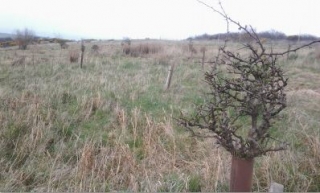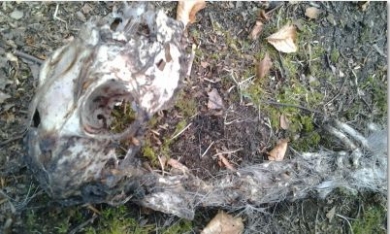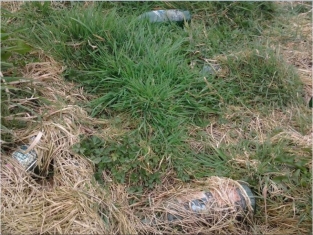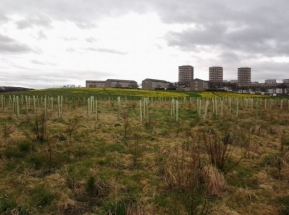By Suzanne Kelly.
By now you probably heard of the environmental carnage on Tullos Hill. It seems likely deer have been killed – despite the public’s wishes, the improbability of trees growing, and the bad science behind the cull. Gorse removal seems to have happened until the last week in March – the cost to insect life, birds and mammals is incalculable.
On my first visit the day after the bulldozers (or whatever trucks were used) cleared a vast swathe of the hill; I was shocked at the quantity of wildflowers, particularly foxgloves which had been ripped apart or thrown aside. I saw several caterpillars dead and dying. I saw a heck of a lot of domestic and industrial debris – and even more rock.
There seemed to be new patches of gorse missing on every visit I made, despite laws meant to protect our dwindling bird population.
I certainly heard far fewer birds than ever before in the years I’d visited the hill – no surprise though, as their gorse habitat was gone. Few deer have been seen since the hunting season opened.
Two men with shotguns were seen in the St Fittick’s area on foot on the night of the 31st March, and one of the hill’s keen observers saw a silver Range Rover several times driving to areas where there were deer.
Sadly, with the help of an acquaintance I made on the hill last week, I was shown this skeleton and nearby fresh deer fur of what would have been a young deer. It reminded me how comparatively small these gentle creatures are.
I for one doubt very much this poor thing starved; it was in woodland and could have eaten leaves and plants.
Was it killed by hungry foxes? Not impossible.
The tree scheme supporters will say that ‘deer have no natural predators’ – an environmentalist will tell you that foxes are known to take the young or infirm (the roe deer usually live 6 or 7 years maximum).
I just hope against hope that this fairly fresh skeleton was not from a deer which had been wounded. This happens all the time. Deer are shot, and depending on where they’ve taken the hit, they can run away to slowly, painfully, bleed out and die, trauma and shock making the suffering worse. Deer are by no means always quickly destroyed.
Shooting, we are told, is far more preferable than tranquilising and moving them, because up to 50% might die. (I however imagine it would be far more preferable to be put to sleep than injured and die of pain, shock and blood loss – or while wounded be eaten alive by a fox).
If indeed the law we now has says it is illegal to tranquilise and move the creatures, the law is in need of change.
It begs the question: is this law and the new laws about the number of deer an area can support creations of a pro-hunting mentality?
The answer can only be yes. I remembered that the reason for the cull was it was the cheapest way to protect the trees – at least Aileen Malone, Pete Leonard and Ian Tallboys said so. Cheaper still would have been to stop this scheme or put the trees elsewhere.
The taxpayer is picking up the tab, no one is saying it is ‘cost neutral’ any longer, and the city had to repay £43,800 for the previous failure on Tullos Hill. This state of affairs is unacceptable. There are trees on Tullos remaining from the pathetic first planting. However, the saplings which are there are totally neglected.
Plenty of tree guards are totally intact. I saw an intact tree guard, and carefully rolled it open – the tree inside was choked by weeds. I left it as I found it. No deer was responsible for this and the many similar failures. Just human negligence
I note that the more robust tubes were used at the St Fittick’s site – this undoubtedly because anyone with common sense could tell the salt spray and the powerful winds from the North Sea would stop any trees from growing (could this be why there isn’t already a forest on St Fitticks?).
Virtually all of the tubes at St Fitticks are still standing and are undamaged by deer. Anyone who says differently should show me where there has been any deer browsing at St Fitticks.
Mr Tallboys, the ranger, had put together a presentation which shows a picture of deer standing amid the St Fitticks tubes.
Deer do move in that area. However, there is plenty of evidence for there being vandalism – and for the city and its rangers totally neglecting to protect and care for the trees it did plant.
I looked into many of the St Fitticks tree guards, all of which were undamaged. There are quite a number of tiny oak trees which had never even made it one third of the way up the tube. There were some tubes which were completely, utterly empty of any tree.
The entire site is choked by weeds and rocky soil is again an issue (although not as bad as on Tullos). The deer simply did not, could not damage the St Fitticks trees: the evidence suggests that the killer was neglect and ignorance as well as weeds and weather.
There will probably be deer deaths on the road – about a third of the gorse they would have sheltered in on the hill is gone.
It is not too late to bring this thing to a halt, investigate those involved in forcing this scheme on an unwilling local population, and it’s not too late to undo the damage.
Halt the scheme, save taxpayer money, and continue to support the meadowlands scheme.
The trees did not grow before. They are not going to grow now.
Coming soon – an article on the new tree scheme / deer cull developments







